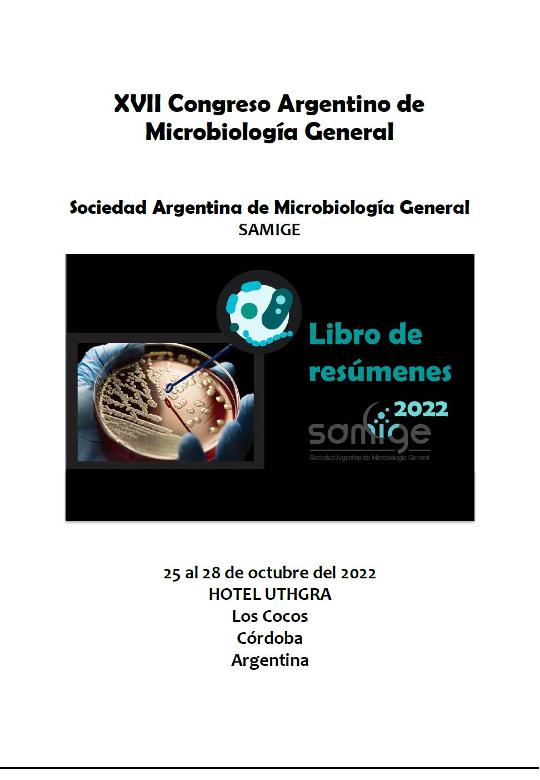Mostrar el registro sencillo del ítem
dc.contributor.author
Lacosegliaz, Mariano José

dc.contributor.author
Torres, Mariela Analía

dc.contributor.author
de Cristobal, Ricardo Ezequiel

dc.contributor.author
Nieto Peñalver, Carlos Gabriel

dc.date.available
2023-09-01T14:57:28Z
dc.date.issued
2022
dc.identifier.citation
Impact of NaCl on the macromolecular composition of unsaturated Pseudomonas capeferrum WCS358 biofilms; XVII Congreso Argentino de Microbiología General; Los Cocos; Argentina; 2022; 154-154
dc.identifier.uri
http://hdl.handle.net/11336/210164
dc.description.abstract
High NaCl concentrations in soils affect negatively the production, nutritional, and economic value of crops, as well as its biodiversity. In response to this problem, a large number of studies on plant growth-promoting rhizobacteria (PGPR) have been developed, as they may improve the uptake of water and nutrients and alleviate different types of stresses in plants. These bacteria colonize the rhizosphere forming biofilms that are exposed to constant fluctuations in water availability. For this reason, in this work, we utilize an unsaturated biofilm model as an approximation to the conditions to which rhizobacteria are exposed. Pseudomonas (P.) capeferrum WCS358 produces pyoverdine and induces a systemic response in plants. Its Quorum Sensing (QS) system regulates physiological processes relevant to the colonization of the host and survival. The aim of this work was to analyze the impact of salt stress on growth and the characteristics of the unsaturated biofilm of P. capeferrum WCS358, and the influence of QS regulation. For this, we employed polycarbonate membranes and an artificial root exudates culture medium supplemented with 0.2 M NaCl as saline stress. Membranes were inoculated with bacterial suspensions (0.1 OD600) and incubated at 30 °C for 72 hours. Unsaturated biofilms were broken up by vigorously vortexing the membrane in 1 mL physiological solution. CFU mL-1 was determined after plating serial dilutions. Carbohydrates were quantified using the phenol?sulfuric method with glucose as a standard, extracellular proteins were quantified using the Bradford method. Acyl homoserine lactones (AHLs) production was determined after solvent extraction, separation by thin-layer chromatography, and subsequent detection with bioassays developed with Agrobacterium (A.) tumefaciens NT1 (pZLR4). Results showed that neither saline stress nor QS activity decreased biofilm growth of P. capeferrum WCS358. While the attenuation of the QS activity augmented 13% of the exopolysaccharides in the unsaturated biofilms, NaCl decreased by 28% of these values. Proteins in the matrix were not affected by QS. However, saline stress increased by 30% the protein concentration. RP-TLC developed with A. tumefaciens NT1 (pZLR4) showed smaller and weaker spots of AHLs. We conclude that saline stress and the QS system modify the characteristics of the unsaturated biofilms of P. capeferrum WCS358. At the same time, NaCl modulates the QS activity of this microorganism. These results are relevant for a PGPR, considering the large surfaces of saline soils in our country.
dc.format
application/pdf
dc.language.iso
eng
dc.publisher
Sociedad Argentina de Microbiología General
dc.rights
info:eu-repo/semantics/openAccess
dc.rights.uri
https://creativecommons.org/licenses/by-nc-sa/2.5/ar/
dc.subject
NaCl
dc.subject
UNSATURATED BIOFILM
dc.subject
QUORUM SENSING
dc.subject
PSEUDOMONAS CAPEFERRUM WCS358
dc.subject.classification
Biotecnología Medioambiental

dc.subject.classification
Biotecnología del Medio Ambiente

dc.subject.classification
INGENIERÍAS Y TECNOLOGÍAS

dc.title
Impact of NaCl on the macromolecular composition of unsaturated Pseudomonas capeferrum WCS358 biofilms
dc.type
info:eu-repo/semantics/publishedVersion
dc.type
info:eu-repo/semantics/conferenceObject
dc.type
info:ar-repo/semantics/documento de conferencia
dc.date.updated
2023-08-14T11:00:04Z
dc.journal.pagination
154-154
dc.journal.pais
Argentina

dc.description.fil
Fil: Lacosegliaz, Mariano José. Consejo Nacional de Investigaciones Científicas y Técnicas. Centro Científico Tecnológico Conicet - Tucumán. Planta Piloto de Procesos Industriales Microbiológicos; Argentina
dc.description.fil
Fil: Torres, Mariela Analía. Consejo Nacional de Investigaciones Científicas y Técnicas. Centro Científico Tecnológico Conicet - Tucumán. Planta Piloto de Procesos Industriales Microbiológicos; Argentina
dc.description.fil
Fil: de Cristobal, Ricardo Ezequiel. Consejo Nacional de Investigaciones Científicas y Técnicas. Centro Científico Tecnológico Conicet - Tucumán. Instituto Superior de Investigaciones Biológicas. Universidad Nacional de Tucumán. Instituto Superior de Investigaciones Biológicas; Argentina. Universidad Nacional de Tucumán. Facultad de Bioquímica, Química y Farmacia. Instituto de Química Biológica; Argentina
dc.description.fil
Fil: Nieto Peñalver, Carlos Gabriel. Consejo Nacional de Investigaciones Científicas y Técnicas. Centro Científico Tecnológico Conicet - Tucumán. Planta Piloto de Procesos Industriales Microbiológicos; Argentina. Universidad Nacional de Tucumán. Facultad de Bioquímica, Química y Farmacia. Instituto de Microbiología; Argentina
dc.relation.alternativeid
info:eu-repo/semantics/altIdentifier/url/https://samige.org.ar/wp-content/uploads/2022/10/Libro-de-Resumenes-SAMIGE-2022_final.pdf
dc.conicet.rol
Autor

dc.conicet.rol
Autor

dc.conicet.rol
Autor

dc.conicet.rol
Autor

dc.coverage
Internacional
dc.type.subtype
Congreso
dc.description.nombreEvento
XVII Congreso Argentino de Microbiología General
dc.date.evento
2022-10-25
dc.description.ciudadEvento
Los Cocos
dc.description.paisEvento
Argentina

dc.type.publicacion
Book
dc.description.institucionOrganizadora
Sociedad Argentina de Microbiología General
dc.source.libro
Libro de resúmenes del XVII Congreso Argentino de Microbiología General
dc.date.eventoHasta
2022-10-28
dc.type
Congreso
Archivos asociados
